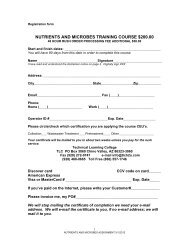Pump Primer 1 $100 - 8 Hours - Technical Learning College
Pump Primer 1 $100 - 8 Hours - Technical Learning College
Pump Primer 1 $100 - 8 Hours - Technical Learning College
Create successful ePaper yourself
Turn your PDF publications into a flip-book with our unique Google optimized e-Paper software.
Obviously, when velocity becomes a factor it must have a direction, and as previously<br />
explained, the force related to the velocity must also have a direction, so that Pascal’s law alone<br />
does not apply to the dynamic factors of fluid power.<br />
The dynamic factors of inertia and friction are related to the static factors. Velocity head and<br />
friction head are obtained at the expense of static head. However, a portion of the velocity head<br />
can always be reconverted to static head. Force, which can be produced by pressure or head<br />
when dealing with fluids, is necessary to start a body moving if it is at rest, and is present in<br />
some form when the motion of the body is arrested; therefore, whenever a fluid is given velocity,<br />
some part of its original static head is used to impart this velocity, which then exists as velocity<br />
head.<br />
Volume and Velocity of Flow<br />
The volume of a liquid passing a point in a given time is known as its volume of flow or flow rate.<br />
The volume of flow is usually expressed in gallons per minute (gpm) and is associated with<br />
relative pressures of the liquid, such as 5 gpm at 40 psi. The velocity of flow or velocity of the<br />
fluid is defined as the average speed at which the fluid moves past a given point. It is usually<br />
expressed in feet per second (fps) or feet per minute (fpm). Velocity of flow is an important<br />
consideration in sizing the hydraulic lines. Volume and velocity of flow are often considered<br />
together. With other conditions unaltered—that is, with volume of input unchanged—the velocity<br />
of flow increases as the cross section or size of the pipe decreases, and the velocity of flow<br />
decreases as the cross section increases. For example, the velocity of flow is slow at wide parts<br />
of a stream and rapid at narrow parts, yet the volume of water passing each part of the stream<br />
is the same.<br />
Bernoulli's Principle<br />
Bernoulli's principle thus says that a rise (fall) in pressure in a flowing fluid must always be<br />
accompanied by a decrease (increase) in the speed, and conversely, if an increase (decrease)<br />
in, the speed of the fluid results in a decrease (increase) in the pressure. This is at the heart of a<br />
number of everyday phenomena. As a very trivial<br />
example, Bernoulli’s principle is responsible for<br />
the fact that a shower curtain gets “sucked<br />
inwards'' when the water is first turned on. What<br />
happens is that the increased water/air velocity<br />
inside the curtain (relative to the still air on the<br />
other side) causes a pressure drop.<br />
The pressure difference between the outside and<br />
inside causes a net force on the shower curtain<br />
which sucks it inward. A more useful example is<br />
provided by the functioning of a perfume bottle:<br />
squeezing the bulb over the fluid creates a low<br />
pressure area due to the higher speed of the air,<br />
which subsequently draws the fluid up. This is<br />
illustrated in the following figure.<br />
Action of a spray atomizer<br />
<strong>Pump</strong> <strong>Primer</strong> I Course © 12/1/2012 (866) 557-1746 www.ABCTLC.com<br />
40
















